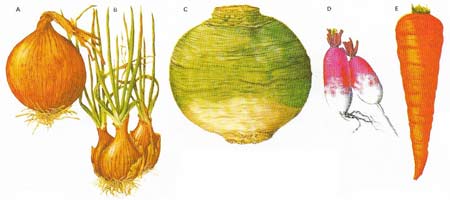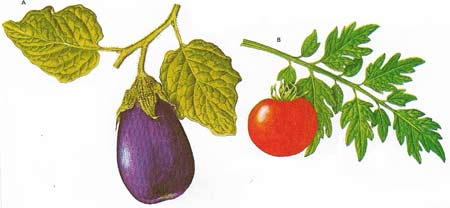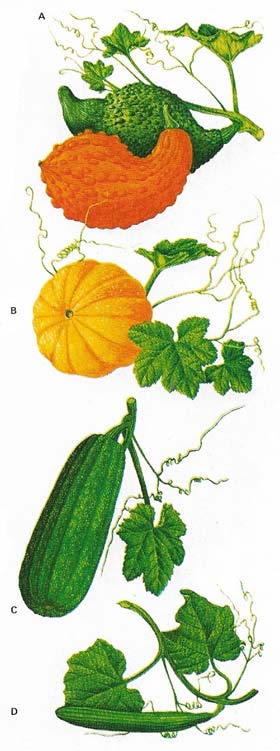vegetable

Figure 1. Legumes and grains can both be eaten as vegetables. Pulses, some having edible pods, include peas (A), broad beans (B), and runner beans (C). Sweet corn (D) is a variety of maize bred to be cut before the grains ripen. Frost-resistant varieties have extended the range of sweet corn.

Figure 2. Cabbage (A), cauliflower (B), and brussels sprouts (D) all belong to the same Brassica species although they differ greatly in appearance. Like curly kale (C), they are all hardy and some varieties can stand quite cold winters.

Figure 3. Leafy plants for salads and cooking include chicory (A), whose young shoots are forced in winter, lettuce (B), and spinach (C), of which there are two species to cover winter and summer cropping.

Figure 4. Bulbs and roots are widely grown. Onions (A) were an important crop in ancient Egypt. The shallot (B) forms new bulbs by the side of the old. The "roots" of turnips (C) and radishes (D) are actually modifications of the stem base. The carrot (E) is a biennial that builds up a food store in its tap root for the following year.

Figure 5. Tropical vegetables that now have a wide distribution are the aubergine (A) and the tomato (B); they are fruits developed from flowers.

Figure 6. Sweet peppers (A) belong to the genus Capsicum, native of the American tropics. The seed pods of okra or gumbo (B) are picked ten weeks after planting.

Figure 7. Vegetables are the major source of vitamins. For instance 100 grams (4 ounces) of tomatoes contain 117 micrograms of vitamin A, 0.10 mg of vitamin B (thiamie and riboflavin) and 20 milligrams of vitamin C. These quantities are used here as comparison units for vitamins found in an equal weight of other vegetables.
A vegetable is any plant whose leaves, flowers, roots, stems, or fruits are edible. "Vegetable" is used for those plants that are eaten in main courses of meals, usually after cooking, while the general term "fruit" refers to plants used as appetizers or desserts, or eaten out of the hand. Thus, botanically a tomato is a fruit, but it is popularly considered a vegetable.
Vegetables are important to a healthy human diet even if the energy requirements of the body are met by starches from grains and roots and by protein of animal or vegetable origin. Fresh vegetables provide vitamins that may be lacking in the rest of the diet. They also give the diet the bulk that helps to keep the digestive tract in good working order. Furthermore, they add to the enjoyment of food by providing variety. The seeds, pods, leaves, stems, and roots are used.
Pods and seeds
The young seeds or fleshy pods of immature pulses are widely eaten (Figure 1). Peas (Pisum spp) and broad beans (Vicia sp) originated in the Old World. French, haricot, and dwarf beans, all Phaseolus sp, originated in America. Most of these are eaten as pods, although some are allowed to mature or may be shelled out like green peas (flageolets).
Most versatile of all the vegetable groups are the brassicas, which include both leaf and root types, and others where the immature flower head is eaten. Many are sub-species of Brassica oleracea, whose area of origin is not known; they include cabbages, brussels sprouts, cauliflower, and broccoli (Figure 2).
Other leafy brassicas are Chinese mustard (B. juncea), kale (B. oleracea), and Chinese cabbage (B. pekinensis). The root species, in which the "root" is actually a modified stem, include kohlrabi (B. caulorapa), swede (B. napobrassica) and turnip (B. rapa). Other leaf vegetables that are widely grown include spinach (Spinacia oleracea) and the Swiss chard (Beta cicla), lettuce (Lctctuca saliva), endive (Cichorium ertdivia) and chicory (C. intybus) (Figure 3).
Less hardy because of their sensitivity to frost, but cultivated for many years in temperate as well as tropical climates, are the cucumbers (Cucumis sp) and several species of the genus Cucurbita, which includes the marrow, squash and pumpkin. In all of these it is the immature fruit that is eaten.
 |
| The fruits of the cucurbits are soft-fleshed with a high water content and include winter squash (A), pumpkin (B), vegetable marrow (C), and its smaller version, the courgette, and the cucumber (D). The latter have been cultivated all over the world for centuries. |
Fruiting species
A number of fruiting species botanically related to the potato came with it from America. Of these the most important today is the tomato (Lycopersicum esculentum) (Figure 5B), although it was originally grown in Europe as a purely ornamental plant. Others in this group are aubergine or egg plant (Solanum melongena) (Figure 5A) and sweet pepper (Capsicum annuum) (Figure 6). These plants figure increasingly in international trade, and are largely grown in glasshouses.
Root vegetables, which cover a wide botanical range, have always been a most important winter food, because many are biennials, whose roots carry the energy stock for the following year's flowering. Examples are the tap-rooted carrot (Daucus carrota) (Figure 4E) and parsnip (Pastanaca saliva), whose wild forms are common all over Europe. The beetroot (Beta saliva) is one variety of a versatile species that includes the sugar beet and the marigold. Radishes (Raphanus sp) (Figure 4D) have also been developed from common wild plants in Europe and Asia, where they are still weeds in arable crops on some soils.
The genus Allium adds flavor to diets in many parts of the world. Vegetables of this genus include the onion (A. cepa) (Figure 4A) and its varieties, shallot (A. ascalonicum), leek (A. porrum) from the Mediterranean region and garlic (A. sativum) from central Asia. Without one or other of these, regional cookery would be much less interesting.
Plants such as celery (Apium graveolens) and sea-kale (Crambe maritima) are cultivated for their blanched stems. The young stems of Asparagus officinalis are considered a particular delicacy. Rhubarb (Rheum rhaponicum) is another stem vegetable of commercial importance in temperate countries. The globe artichoke (Cynara scolymus) is cultivated for its edible flower buds — as well as its looks.
 |
| Young shoots of asparagus (A) are grown as a luxury vegetable in beds that may remain in production for many years. Rhubarb (B), a member of the dock family, has poisonous leaves but the edible young stems are eaten in spring. Growth may be forced in darkened sheds. |
The tropics support a wide variety of both root and leaf vegetables, most of which are mainly eaten locally. Two that have become more widely familiar are the green bananas or plantains, which are prominent in so much Creole cookery, and okra or gumbo (Hibiscus esculentus), which is a close relation of cotton.
Cultivation and preservation
Vegetables lend themselves to small-scale cultivation in most parts of the world, by amateurs as well as professional cultivators; much of their production is still on small intensive holdings, largely run by family labor. However, with urbanization a larger proportion of the main species is grown on a field scale by general farmers or on big commercial holdings in areas such as California, where the weather is predictable, and irrigation combined with plentiful sun makes for quick growth and high yields for the cultivators.
Sophisticated handling and packing, with refrigerated transport, make it possible to move even highly perishable vegetables into distant markets in a condition as good as that of produce grown on the very outskirts of any conurbation.
Large-scale vegetable production has also been furthered by the technique of deep freezing. A crop with a comparatively short season, such as the green pea, can be made available to consumers all over the world throughout the year. It can also be produced to high standards of quality in the field and in the processing plant, while inferior grades are diverted to other forms of preservation, such as canning and drying.


